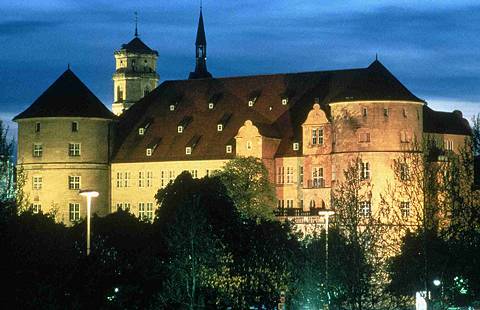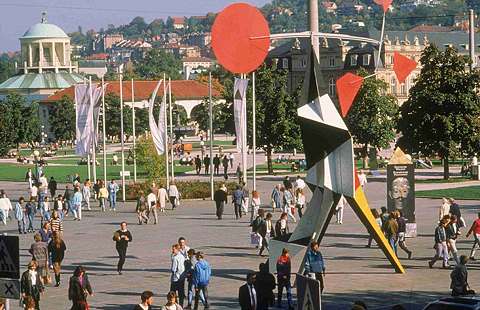|

An opera of extremes
Stuttgart Opera's 'Simplicius Simplicissimus'
by Karl Amadeus Hartmann,
reviewed by RODERIC DUNNETT
Just a few minutes in the Altes Schloss at Stuttgart, the former royal palace which now houses the stunning Württemburgisches Landesmuseum, with its showpiece royal jewels, clocks and Celtic remains, or in the adjacent Schlossgarten park, brings it home to you that this indeed was a German capital city. Very nearly enclosed in the Roman Empire when the limes joining Rhine to Danube became Rome's new frontier in the first century AD, Stuttgart and the state of Baden-Wurttemberg have been at the forefront of Germany's arts, music -- and manufacturing -- for centuries. In short, the city of Stuttgart is a cultural paradise.

The Altesschlosse, Stuttgart. Photo © Stuttgart Marketing GmbH
|
Stuttgart's Opera, housed in the Staatstheater with the State Ballet and Theatre companies, has a star studded history. Carl Maria von Weber was here in the 1800s, penning most of his eminently revivable opera Silvana in Stuttgart. The young composer served as the hapless secretary/treasurer to the Duke's spendthrift brother, before falling out with the Duke (soon, thanks to a staged meeting with Napoleon at nearby Ludwigsburg Palace, to be dubbed King); Weber nearly ended up in the hilltop prison eyrie of Hohenasperg for complaining about all the graft. Meyerbeer and Wagner conducted here. Max von Schillings, the pioneering conductor and Strauss contemporary discredited by a tragically shortlived allegiance to the Nazis (he died in July 1933 before Hitler's rule got going) gave premières of his own wonderful kammeropera Mona Lisa, and of Zemlinsky's Florentine Tragedy; one of his assistants was the young British composer, Cecil Coles. More recently, Ferdinand Leitner's admirable reign in charge spanned almost twenty years (1950-69), coinciding with the vital period when Wieland Wagner worked and directed at Stuttgart after the war. A Modernist pedestrian bridge worthy of this city of Architectural experiment -- where Le Corbusier and Mies van der Rohe tested out their groundbreaking designs -- honours Leitner, near where the Schlosspark abuts the main railway station.

Koenigstrasse, Stuttgart. Photo © Stuttgart Marketing GmbH
|
More recently Stuttgart's cultural reputation got a massive upward heave thanks to John Cranko's twelve year spell as ballet director. The art gallery, of world class standard (with an amazing sequence of Burne Jones to outdo Birmingham) has been expanded with stylish new spaces just across from the park-girt Staatstheater. A series of Philip Glass operas staged by artist-designer-director Achim Fryer caught the imagination in the 1980s; so did his famous, toybox-like staging of Der Freischütz. Under Wolfgang Gönnewein's leadership, Stuttgart's tradition and name positively flourished. The recent staging of Franz Schreker's Die Gezeichneten (The Marked, or The Damned), with the mesmerising Gabriel Sade in the lead role of Alviano, only confirmed the extraordinary quality and confidence of this inventive opera house, where an audience thirsty for fresh insights goes readily along with the innovations. Two revivals later, it still plays to packed houses.
Continue >>
Copyright © 6 June 2004
Roderic Dunnett, Shropshire UK

|

